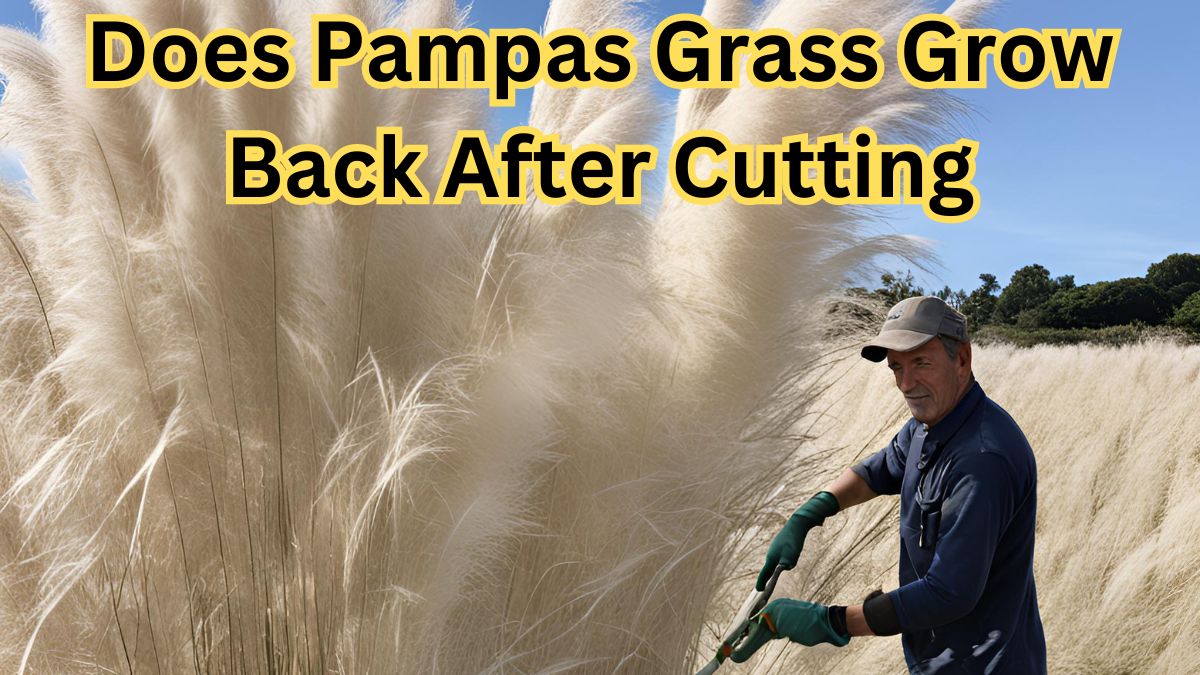“Does Pampas Grass Grow Back After Cutting?” This is a question that many gardening enthusiasts and homeowners often ask. Pampas grass, with its tall feathery plumes and hardy nature, is a popular choice for many landscapes. But what happens when it’s time for a trim? Will this resilient plant bounce back, or have you stunted its growth for good? In this post, we delve into the life cycle of pampas grass, exploring its regenerative abilities and providing you with the best practices for cutting and maintaining this beautiful yet robust plant. So whether you’re a seasoned gardener or a curious beginner, stay tuned as we unravel the mysteries of pampas grass!
Understanding Pampas Grass
Description of Pampas Grass (Cortaderia selloana)
Pampas Grass is a perennial grass native to South America, primarily Argentina, Chile, and Brazil. It’s known for its graceful, arching stems and fluffy, white or pale pink plumes. The plant has a strikingly bold appearance that can create a dramatic effect in the garden. This grass grows in a clump-forming habit and is fast-growing. Mature clumps can reach up to 8 feet (2.4 meters) in width and 6 to 10 feet (1.8-3 meters) in height. The plumes can add 2 to 3 feet (60-90 cm) to the plant’s height. The flowers are dense, fluffy plumes that appear in late summer and persist into winter. They can range from silvery-white to pale pink, depending on the variety. The long, slender leaves are arching, with a grey-green color. They are razor-edged, making handling the plant difficult without protective gloves.
Growth Habits and Lifecycle
Pampas Grass is a large ornamental in the Poaceae (grass) family originating from South America. These grasses produce tall, slim, weeping blades that can easily reach over a meter in length. The grass tends to congregate into tussocks, or clumps of grass. The showiest part of these plants is the tall silvery-white, feather-like plumes. These plumes are soft to the touch and make for an interesting accent in a garden which can be seen very well over other plants.
Pampas grass is relatively easy to grow from seed, and the plant will reach full maturity and bloom within 2-4 years. It is also a perennial, meaning that it will come back year after year for 15 years or more. In the spring, pampas grass will produce numerous bulbs, which can then be transplanted to create new plants.
The Importance of Pruning Pampas Grass
Why Pruning is Necessary
Pruning pampas grass is essential for several reasons. Firstly, it helps control the size of the grass. Pampas grass can grow rapidly and form dense clumps, and if left unpruned, it can easily get out of control and grow to a larger size than you can accommodate in your garden.
Secondly, regular pruning is necessary to improve the control of pests. Pampas grass is an invasive species that can take over an area in less than a year. It can create unsightly patches of growth on your lawn, and it’s difficult to remove.
Lastly, pruning is vital for restating the vigor of the grass. Pruning pampas grass at least once a year in late winter or early spring is vital for optimal growth and to maintain its stunning foliage. As new shoots emerge from the ground, it’s the perfect time to cut back the old growth, allowing the plant to flourish and showcase its beauty throughout the warmer months.
What happens if you don’t prune pampas grass?
Benefits of Regular Trimming for Plant Health and Aesthetics
Regular pruning is beneficial for both the health of the pampas grass and its aesthetic appeal. Pruning stimulates better growth and helps prevent the plant from becoming overgrown and unsightly.
Once established, pampas grass is low maintenance and only requires yearly pruning to keep it neat. As long as you keep on top of this annual trim, the rest is easy. And remember to keep the best stems for arranging in on-trend displays indoors.
Pruning also improves the appearance of your lawn. Not only will this procedure help curb its growth, but it will also enhance the look of your garden.
Best Time to Cut Pampas Grass
Optimal Seasons for Pruning
The best time to cut back pampas grass is in late winter just before the plant begins sending up new foliage. This timing allows for a fresh start and encourages healthy regrowth during the growing season. Waiting until the end of winter allows you to enjoy the plumes all year. Every once in a while, clumps of pampas grass form smaller clumps off to the side. Remove these clumps when you do your annual pruning to prevent overcrowding and to preserve the shape of the clump.
Weather Considerations and How They Affect Growth
Pampas grass grows best in hot and humid areas but can thrive even in colder regions, as long as it grows in full or partial sun, and well-draining loamy soil. It prefers regions with a temperate climate and can tolerate a wide range of temperatures, from as low as -15°C (5°F) to as high as 40°C (104°F). However, it generally thrives in areas with moderate temperatures, ranging from 20°C to 30°C (68°F to 86°F) during the growing season.
Pampas grass can tolerate light shade, but like turf grass, it grows best in full sunlight. Reduced light deprives the grass of normal growth processes. It becomes less resistant to disease, and it has to compete with larger plants for water and nutrients.
In the winter, when temperatures dip, the plant will go dormant. If the thermometer drops to 20 degrees Fahrenheit or below, frost damage can occur, but it is unlikely to kill the plant.
How to properly cut Pampas Grass
Here is a step-by-step guide on how to properly cut Pampas Grass:
Tools Needed:
- Gloves: Pampas grass has sharp edges that can cause cuts and scratches.
- Long-sleeved shirt and long pants: To protect your skin from the sharp blades of the grass.
- Safety glasses: To protect your eyes from flying debris.
- Pruning shears: For smaller clumps of grass.
- Power hedge trimmer or chainsaw: For larger, mature clumps of grass.
- Rake and large bags: For cleanup.
Safety Precautions:
- Always wear protective clothing and safety glasses to protect yourself from the sharp blades and flying debris.
- Be aware of your surroundings to avoid tripping or falling while carrying the tools or the cut grass.
- If using power tools, ensure you are familiar with their operation and safety features.
Steps to Cut Pampas Grass:
- Dress Appropriately: Put on your gloves, long-sleeved shirt, long pants, and safety glasses.
- Prepare the Area: Clear the area around the pampas grass to give yourself room to work.
- Tie the Grass: Using a rope or bungee cord, tie the pampas grass together in the middle to create a bundle. This makes it easier to cut and clean up.
- Cut the Grass: Using your pruning shears or power tool, cut the grass about 1 to 2 feet from the ground. Be sure to cut in a straight line for a neat appearance.
- Clean Up: Use your rake to gather the cut grass. Dispose of the cut grass in your large bags.
- Inspect the Area: Check the area for any missed blades of grass and pick them up.
post-cutting care of Pampas Grass
Here are some tips for post-cutting care of Pampas Grass:
Watering:
- Pampas grass is drought-tolerant and typically doesn’t require frequent watering. However, after cutting, it’s a good idea to water the plant thoroughly to help it recover.
- Water the base of the plant, not the foliage, to prevent the growth of mold or fungus.
Fertilizing:
- Apply a balanced, slow-release fertilizer in the spring as new growth appears. This will provide the necessary nutrients for the plant to grow back strong and healthy.
- Avoid over-fertilizing as this can lead to weak, leggy growth.
Monitoring Regrowth and Signs of Healthy Recovery:
- New growth should appear at the base of the plant in the spring. This is a sign that the plant is recovering well from the cutting.
- Healthy pampas grass will have strong, upright growth and the foliage will be a vibrant green color.
- If the plant appears weak, or the growth is sparse or yellow, this could be a sign of over-watering, poor soil conditions, or a lack of nutrients.
Common Mistakes to Avoid
Here are some common mistakes to avoid when cutting Pampas Grass and how to correct or prevent them:
1. Cutting Too Early or Too Late in the Season:
- Mistake: Cutting pampas grass too early in the fall or too late in the spring can harm the plant’s growth cycle.
- Correction: The best time to cut pampas grass is in late winter or early spring before new growth begins.
2. Not Wearing Proper Protective Gear:
- Mistake: Not wearing gloves, long-sleeved shirts, long pants, and safety glasses can lead to injuries from the sharp blades of the grass.
- Correction: Always wear appropriate protective gear when handling pampas grass.
3. Not Tying the Grass Before Cutting:
- Mistake: Cutting the grass without first tying it together can lead to a messy cleanup and uneven cuts.
- Correction: Use a rope or bungee cord to tie the grass together into a bundle before cutting.
4. Cutting Too High or Too Low:
- Mistake: Cutting the grass too high can result in a ragged appearance, while cutting too low can harm the plant’s ability to regrow.
- Correction: Aim to cut the grass about 1 to 2 feet from the ground for a neat appearance and healthy regrowth.
5. Overwatering or Overfertilizing After Cutting:
- Mistake: Overwatering or overfertilizing the grass after cutting can lead to weak, leggy growth or the development of mold or fungus.
- Correction: Water the base of the plant thoroughly after cutting, but avoid overwatering. Apply a balanced, slow-release fertilizer in the spring as new growth appears, but avoid over-fertilizing.
Why Do You Spray Hairspray on Pampas Grass?
Conclusion
In conclusion, Pampas Grass is a resilient and versatile plant that can withstand cutting and still bounce back with vigor. Its ability to regrow after cutting not only makes it a sustainable choice for gardeners but also allows for its beauty to be enjoyed year after year. Whether you’re looking to add some texture to your landscape, create a natural privacy screen, or simply enjoy its feathery plumes, Pampas Grass proves to be a plant that is as hardy as it is attractive. Remember, proper care and maintenance are key to ensuring your Pampas Grass thrives, so don’t hesitate to cut back when necessary.
FAQS
Here are some FAQs:
1. How long does it take for pampas grass to regrow?
- The regrowth of pampas grass can depend on several factors including the health of the plant, the growing conditions, and the care it receives. Generally, you should start to see new growth at the base of the plant in the spring following the cutting. By the end of the growing season, the grass should have fully regrown.
2. Can cutting pampas grass too much harm it?
- Yes, cutting pampas grass too much or too often can harm the plant. If the grass is cut too low, it can harm the plant’s ability to regrow. Similarly, cutting the grass too frequently can stress the plant and hinder its growth. It’s generally recommended to cut pampas grass once a year in late winter or early spring.



Pingback: Can you cut pampas grass to the ground?
Pingback: Should you burn or cut pampas grass?
Pingback: Do Cows Eat Pampas Grass? Everything You Need to Know